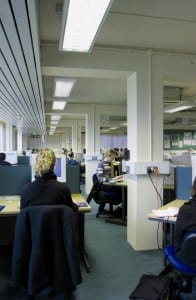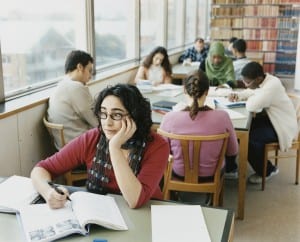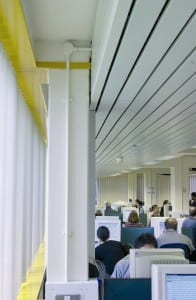University of Reading: S@IL
Innovation

Sail room
The focus of the case study at the University of Reading is the Student Access to Independent Learning (S@IL) zone, located in the building of Humanities, Media and Social Sciences (HUMSS). The S@IL zone is part of longer history of the development of social learning space at the university, which was first developed in the university’s main library ten years ago with ‘touch down’ spaces and small breakout rooms. Reading was, in fact, one of the first universities in the country to develop social learning spaces although this fact has not been well publicised.
The problem for the university was the small amount of informal social learning space that was available was heavily oversubscribed: ‘The students used to queue up outside the library during the summer term because of the lack of space. The thought was that there should be more independent study space across the campus because all of the students could not physically fit inside the library’ (Student).
As a result, there are now a number of S@IL zones across the campus. These spaces work well not only because of the facilities that they offer, but also because they provide meeting points in what is a large and distributed campus: ‘we’re so scattered you’ve got to have areas in each building where people can meet socially for the appropriate interaction’ (Facilities Manager).
The S@IL zone is designed to actively encourage collaboration between students by being large enough to support movement and flow between students and groups, and is furnished with comfortable and moveable seating and tables to be organised by students in ways that fit with their particular learning activities. The space also has Wi-Fi access so that students can use laptops and other mobile technologies.
Vision and Missions
The University was established as University College, Reading in 1892 receiving its Royal Charter in 1926, with full degree awarding powers. The University is based on four sites in and around Reading, with the main location at Whiteknights Campus where the majority of the University’s academic schools are located, along with the main building of the University library and the Students’ Union.
The vision and mission of the university include the aim of contributing to the knowledge economy, being internationally recognised for excellence in teaching and research, and developing a culture that stimulates and supports all staff and students. These aims are very clearly articulated by Reading’s Learning and Teaching Strategy, 2007 – 2011, which is underpinned by four key themes: academic excellence, a supportive teaching and learning community, a stimulating student experience and active staff engagement. Central to the learning and teaching strategy is the notion of an inspiring leaning environment within a research-based culture.
Leadership and Governance

University Library
In terms of the development of pedagogical issues across the university, the key committee is the University Board for Teaching and Learning chaired by the Pro-Vice-Chancellor for Teaching and Learning. The Board has five standing subcommittees, which consider aspects of teaching and learning and establishes working parties on particular issues. Under the supervision of the University Board for Teaching and Learning, operational responsibility for monitoring, managing and developing programmes rests primarily with faculties.
Key to the development of the work of the committees is the way in which the communication system works within and between the committee structures. Communication is aided by the fact that each faculty has a Director of Teaching and Learning, who acts as a conduit for information between the faculties and senior management, facilitating a cascade of information up and down the organisational structure. The committee structure also has good cross-representation links from each of the departments on all of the committees and the university works hard to ensure that there is an appropriate range of experience on each committee group.
A central element of this is the university’s Teaching and Learning Facilities group, which brings staff and students together to challenge and think about teaching and learning and space planning: ‘It is the one place where you have academics, estates, IT services, students and library staff. The representatives of this group are very active and go out and consult with colleagues and do a good job of representing the interests of their faculties. You can be sat in this meeting and you’ll hear somebody give their view and think, I hadn’t thought about that, I hadn’t seen it from that perspective, we should be doing that. So I think this group does work very well in terms of generating ideas and helping to bring everything together’ (Senior Academic).
The flow of information at the university is also supported by a sense of collegiality and informal dialogue between students and staff at all levels: ‘Reading has always been a collegiate university, you wander around the campus and chat to everyone from the Vice Chancellor to students. This is hugely important to the university and we have a honey pot of locations such as the Dolce Vita café and the café in the library, which allows this to happen’ (Senior Academic).
The decision making process is also supported and guided, in part, by the university’s strategic documents. To improve the readability and user-friendliness of these documents, the university has recently gone through a process of aligning its departmental strategy documents with each other, informed by its corporate strategy, to provide a central organisational direction. The strategy documents have also been condensed into a more accessible one page format to make them more intelligible for staff and students. This process was done in consultation with academics, estates, and students, and facilitated by the Innovation Works centre at the university ( http://www.innovationworks.reading.ac.uk/,) an innovative space that encourages free thinking, creativity and the development of new ideas.
The result for teaching and learning has been the development of a vision that ‘people sign up to in a research intensive university, in a language that makes sense to academics, who are researchers first, and teachers second’ (Senior Manager). In addition, the Teaching and Learning strategy is linked to and informs the development of other departmental strategies: ‘The strategy does communicate what we are trying to do in teaching and learning and has informed other groups in the development of their strategies’ (Senior Academic).
One of the biggest difficulties for the university, and across the sector in terms of space planning, is how to keep the strategic plan aligned to the individual projects: ‘When you go into project mode all of a sudden the walls go up and everybody worries about that particular project and forgets that if they value engineer something out of project A that it’ll have to be picked up by project B’ (Senior Academic).
An important part of the development of space planning has been encouraging academics to engage in academic research to inform debates about the quality of the teaching and learning environment at Reading: ‘We are trying to encourage academics to make their case through research and data analysis to make a compelling argument. Rumour and half truths reported at committees does not tell you what the real problem is, you have to bring evidence to the table, just standing there moaning doesn’t help’ (Senior Manager).
This process of informed decision making about teaching and learning spaces has been led by a senior academic with a background in research into real estate development and how organisations use space to facilitate their business in the private sector and government. This research informed style of academic leadership has helped develop an evidence based approach to the management and development of teaching and learning spaces within the university.
The university has a good relationship with its students, who are involved in its committee structures, and are consulted on matters to do with the development of teaching and learning spaces. However, despite this, there is a feeling amongst the students that they have difficulty in articulating their views: ‘The university is very keen for students to be involved without us necessarily understanding how it all works’ (Student). The National Student Survey has also been a useful way of including the student voice in the development of the university and has resulted in a number of research projects being commissioned.
Developing the brief
The first stage of developing a project brief at Reading is through a feasibility group, which then develops into a project group if the project proves to be feasible. The feasibility group is comprised of colleagues with an interest in the project, selected by the Deputy Vice Chancellor. While some of the project briefs are not as well developed as others, when the project briefing process has gone well it has provided a rigorous ‘inside out design’ that has fully considered the teaching and learning issues. These briefs can then be presented to the architects who can interrogate the issue more fully. There is a recognition by staff involved in developing project briefs that ‘having good quality externals can make or break a project’ ( Senior Academic).
The S@IL zone in the library was a pilot for the provision of social learning area. This idea to develop the project came from information acquired through the library user survey ‘the students didn’t have enough places where they could work in groups, so we put some of the furniture in there which would be useful for collaborative working’ (Senior Academic).

Sail Room
This pilot was then extended across the campus: ‘students did not have enough places where they could work in groups for collaborative learning. There was money left over from a previous project and it was argued very strongly that it should be used to further enhance teaching and learning spaces’ (Senior Manager). There was extensive consultation during the development of the brief for the S@IL zones with academics, students, support staff, and estates to consider how to develop the space.
Initially designed as the solution to a lack of space for social learning, S@IL has come to represent more than the management of space, and now encapsulates the ethos of connecting teaching and research that pervades the university. The university is taking a lead in the sector in terms of the research-teaching nexus through its Applied Undergraduate Research Skills project, a Centre for Excellence in Teaching and Learning (CETL), whose aim is to support enquiry based learning in the undergraduate curriculum. This Centre for Excellence epitomises Reading’s approach to teaching and learning which is to give students the opportunity to develop research skills that will be useful not only in terms of engaging in academic activity, but in enhancing their employability once they have left the institution.
The success of the refurbishment of the S@IL zones in the HUMSS building has put pressure on the university to develop its classroom spaces, some of which are housed in legacy buildings which have been described by some staff as being in the ‘dark ages’.
A key issue for the Learning Landscapes project is to establish working arrangements that involve academics in the development of teaching and learning spaces. In the process of refurbishing its classrooms Reading is already providing an interesting model of good practice. This model is based on the notion of ‘walk-arounds’, involving academics from different disciplines, facilities managers and colleagues from the Centre for the Development of Teaching and Learning, as well as representative from IT, conducting visits together to teaching spaces that are due for redevelopment. The purpose of these ‘walk-arounds’ is to discuss what works in terms of teaching and learning within the spaces in which teaching and learning takes place. These ‘on-site’ discussions provide the opportunity for colleagues from different subject areas and professional cultures to challenge each other’s perceptions about what types of spaces make for effective teaching and learning. This process can ‘get engagement from academics and encourages them to really start to think about the issues’ (Senior Academic).
Project Management
The university does not have a formal system of project management but uses a process based on a mixture of experience and good relationships that have been established across the university. In terms of experience, there is a culture of learning from previous projects and using them to feed into future projects. This is particularly apparent from the way in which the S@IL zone has affected the provision of other teaching and learning spaces. Perhaps one of the most important lessons the university has learned in terms of space planning is providing feasibility groups and project groups with a degree of flexibility within projects to experiment and innovate.
Research and Evaluation
In terms of post-project evaluation, the university acknowledges that more could be done in this area, both at the University of Reading, and across the sector ‘I do not think that anyone does post-project evaluation well to be honest’ (Senior Manager). The university does use institutional data about space utilisation, which allows it to evaluate whether the right space is being allocated for the appropriate forms of teaching and learning activities. Information is also gathered through the National Student Survey, as well as research conducted to evaluate the student experience of IT. Significantly, the university is using the findings from this research to develop its space planning ‘I think Reading is moving in the right direction, building on its experiences, and getting feedback from students and staff’ (Estates Manager).
Recent Comments